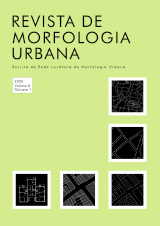Abstract
To identify in the cities of Olivenza (Spain) and in the city of Florianópolis (Brazil), marks of the dispute between Portuguese and Castilians to mark Iberian borders or for the control of America's southern Atlantic south coast is the first objective of this article. These cities will be bargaining chips in Treaties in one of the many attempts to resolve these conflicts. The urban defense structures built in both spaces in the middle of the XVIII century marked the territory. The intended reconstruction seeks in the current urban space of Florianópolis and Olivença the signs that denounce the struggle between Iberians in the urge to satisfy their needs and desires. The Portuguese borders most threatened by invasions, in this period, are the southern border of the colony Brazil and the southeastern Iberian border on the bank of the River Guadiana. The enemy was the same in both cases: the Castilians. Thus, in the first half of the 18th century, military reinforcement in these two frontiers, which were so physically distant, yet so close in their vulnerability, was a constant. To state that Santa Catarina Island and the Iberian region where Olivença is located have no physical, geographical or social resemblance is to state the obvious. But we can reflect on the materiality arising from historical episodes.
References
Acruche, H. F. (2014) Entre a lei e a prática: comércio de escravos e soberania dos Estados ibéricos no Rio da Prata colonial. Angelus Novus, V(7), p. 67-88. Disponível em: https://doi.org/10.11606/ran.v0i7.97816.
Albuquerque, L. (1989) Tratado de Tordesilhas e outros documentos. Lisboa, Publicações Alfa.
Azevedo, J. L. (1912) O Marques de Pombal e sua época. Porto, Renascença Portuguesa.
Boxer, C. R. (1969) A idade de ouro do Brasil: dores de crescimento de uma sociedade colonial. São Paulo, Cia. Ed. Nacional.
Cabral, O. R. (1972) As defesas da ilha de Santa Catarina no Brasil-colônia. Rio de Janeiro, Conselho Federal de Cultura.
Ceballos, R. (2008) Arribadas Portuguesas: A participação luso-brasileira na constituição social de Buenos Aires (1580-1560. Tese de Doutoramento não publicada, Universidade Federal Fluminense, Niteroi, Brasil.
Floripendio (2010) Florianópolis Antigo. Disponível em: http://floripendio.blogspot. com/2010/05/florianopolis-antigo.html. [Consultado em: 24 de junho de 2020]
Goes Filho, S.S. (2004) Fronteiras gaúchas : diplomacia e poder. Revista do Instituto Histórico e Geográfico Brasileiro. 423, 281-300. Disponível em: https://ihgb.org.br/publicacoes/revista-ihgb/item/146-volume-423.html.
Matos Sequeira, G. A. e Rocha Junior (1924) Olivença. Lisboa, Portugalia.
Pauli, E. (1978) A fundação de Florianópolis. Florianopolis, Edeme.
Pizarro Gomez, F. J. (coord.) (2005) Paisajes Urbanos de Extremadura 2. Mérida, Junta de Extremadura.
Marques, J. (1996) A influência das bulas papais na documentação medieval portuguesa. História: revista da Faculdade de Letras da Universidade do Porto. 13, 25-62.
Ribeiro, D. (1999) O povo brasileiro:a formação e o sentido do Brasil. São Paulo, Cia das Letras.
Ruiz, J. M., Ruiz e J. P., Bilbao, F.S. (2007) Estado y territorio em Espana, 1820-1930: La formacion del paisaje nacional. Madrid, Los Libros de la Catarata.
Sanchez Garcia, R. M. e Limpo Piriz, L. A. (1994) El enclave de Olivenza y sus murallas (1230-1640). Cáceres, Universidad de Extremadura-Ayuntamiento de Olivenza.
Santos, M., Souza, M. A. e Silveira, M. L. (1994) Território: globalizaçao e fragmentaçao. São Paulo, Hucitec.
Soja, E. (1993) Geografías pós-modernas: a reafirmaçao do espaço na teoria social crítica. Rio de Janeiro, Zahar.
Vallecilo Teodoro, M.A. (1999) Olivenza en su historia. Badajoz, edición del autor.
Laboratório Nacional de Computação Científica (s.d.) Tratado anulatório – Pardo. Disponível em: http://www.info.incc.br/pardo.html. [Consultado em: 26 junho 2019].
Instituto Histórico e Geográfico de Santa Catarina (s.d.) Fototeca. Disponível em: https://www.ihgsc.org/fototeca. [Consultado em: 26 junho 2019].

This work is licensed under a Creative Commons Attribution 4.0 International License.
Copyright (c) 2020 Milton Luz da Conceição


